Josep Lay, Managing Director of PT Great Giant Pineapple provides some insight for fruitjuicefocus.com
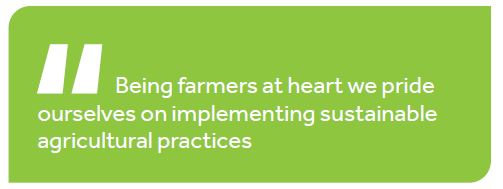
Principal producer
The big four pineapple producers in the world are Thailand, Philippines, Indonesia, and Costa Rica (85-90%). Thailand’s production in 2019 is expected to drop to 1.1 million tonnes. The Philippines production remains stable over recent years, while Costa Rica is now producing more in NFC. Indonesia’s production keeps growing steadily but will not be able to substitute the shortfall of other countries.
A passion for pineapple
PT Great Giant Pineapple PT Great Giant Pineapple (GGP) operate on a 34,000 ha plantation area in Lampung, Indonesia, with some 25,000 employees. This is the world’s single largest integrated green production facility producing more than 700,000 tonnes of pineapple annually. Rainforest Alliance Certified – GGP commits to control every step of the process from plantation to processing and shipping.
Fully traceable
Their system and process allows the company to trace from finished product to a specific planting area. Since our establishment in 1979, PT Great Giant Pineapple’s (GGP) has become the largest private label manufacturer of canned pineapples in the world and a prominent source of premium pineapples. Being farmers at heart we pride ourselves on implementing sustainable agricultural practices, at the core of our business operations. With one in every 4 pineapple originating from GGP, our plantation covers 90,000 acres, and our unrivalled expertise in fruit cultivation is supported by a seamless supply chain alongside our fully integrated facilities.
Sustainable
We began implementing our sustainability initiatives form 1980 by actively maintaining our natural lagoons to harvest rainwater thereby reducing our consumption of ground water. Since then we have invested in various initiatives relating to the environment as well as the social and economic welfare of local communities
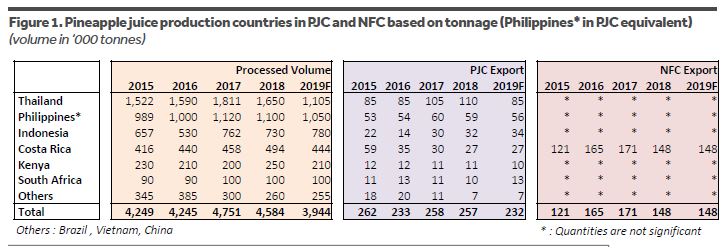
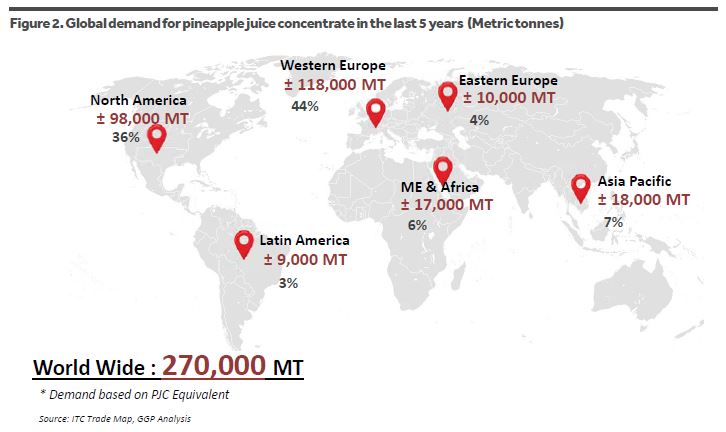
Premium products
GGP are the largest private label manufacturer of canned pineapples in the world serving leading retailers and brands from over 60 countries with a market share of 25%. Premium products include pineapple in pouches, fillings and spreads, canned pineapples and tropical fruit salad, pineapple juice concentrate (PJC), clarified pineapple concentrate (CPC), deionised clarified pineapple concentrate (DCPC), not from concentrate (NFC).
Production overview
Costa Rica pineapple landscape. After reaching a USD200 million record in exports in 2016, in 2018 the value of pineapple juice sold by Costa Rican companies abroad fell to USD104 million. The 2016 advantages such as climate and production problems in South East Asian countries such as Indonesia and the Philippines contributed to the spike in trade.
At the beginning of 2019 there were 44,500 hectares dedicated to fruit cultivation in Costa Rica, however because of high production costs and a drop in International prices predicted by 2021, the cultivated area could fall to 38,000 ha. Growing competition from Colombia, Panama and Ecuador producers who have managed to gain market share in the US and Europe is noted as the reason.
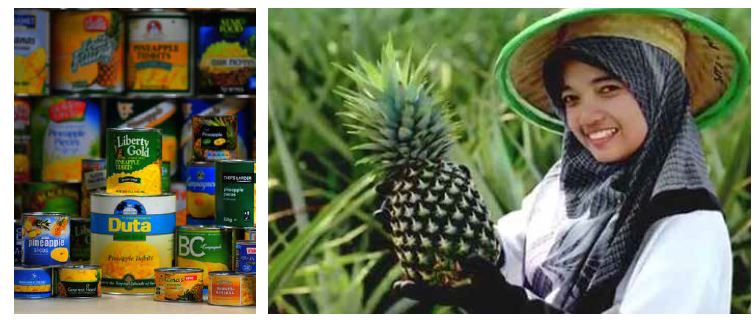
Thailand pineapple harvest
Experiencing the lowest tonnage in the last 20 years Thailand has significant production hurdles to overcome. Due to the very low price of fresh pineapple in previous seasons, farmers did not take care of plantations and this has affected total production volumes, size of fruit and quality. Low yields are predicted to continue in the short term, and also noted is that pineapple production is seen as more labour intensive than other crops such as mango, jackfruit, or rubber. There has been a significant consolidation of canaries in the region from 2011-2019.
Philippines and Indonesia
Philippines has been facing dry spells although predictions are for this to normalise, production is slightly less compared to 2018. The dry season in Indonesia has turned into the ‘long drought’ from May-Nov 2019, not enough rainfalls during those period. Production of Indonesia in 2019 is expected to be higher than 2018. Due to long drought in 2019, Indonesia is expecting a lower production volume in Q1/2020 around by 20%.
Production opportunities for GGP
Thailand is facing a crisis in pineapple industry, not enough workers and no interest for Thailand’s young generation to be a farmer. Declining trends in Thailand’s pineapple tonnage provides opportunities for growth of production volume at GGP. GGP is preparing to minimize the impact of El Nino or drought by investing more water reservoirs. GGP’s water reservoir enable to sustain for 90 days without rain. GGP is a company concerned with ‘Going Green and Sustainability’, creating a food estate that has no waste, every single item is utilized, from the pineapple skin, manure from the cattle operation as well as other solid waste.
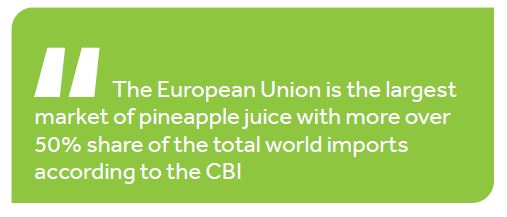
Data from CBI – Market and quality
The European Union is the largest market of pineapple juice with more over 50% share of the total world imports according to the CBI. The Netherlands is the largest European importer of pineapple juice, followed by France and Germany. The major developing country suppliers are Thailand and Costa Rica. Pineapple juice may contain finely divided insoluble solids, but it does not contain pieces of shell, seeds, or other coarse or hard substances or excess pulp. The juice intended for export is usually concentrated and later reconstituted with water due to practical reasons of lowering transportation costs which would otherwise include transport cost for water and packaging.
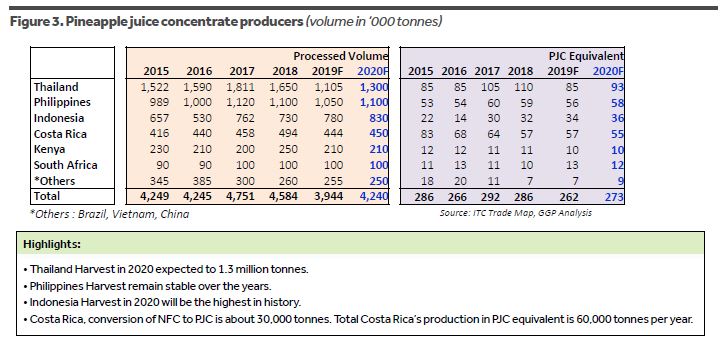
Visit http://www.fruitjuicefocus.com/back-issue-janfeb-2020/ for the full Jan/Feb 2020 Issue.













